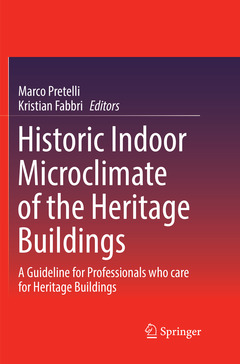Description
Historic Indoor Microclimate of the Heritage Buildings, Softcover reprint of the original 1st ed. 2018
A Guideline for Professionals who care for Heritage Buildings
Coordinators: Pretelli Marco, Fabbri Kristian
Language: English
Subject for Historic Indoor Microclimate of the Heritage Buildings:
Publication date: 08-2018
Support: Print on demand
Publication date: 11-2017
Support: Print on demand
Description
/li>Contents
/li>Biography
/li>Comment
/li>
Architecture and Indoor Microclimate.- Indoor Microclimate.- Historic Indoor Microclimate.- The Study of Historic Indoor Microclimate.- The Investigation.- Buildings Indoor Microclimate Quality (IMQ): Assessment and Certification.- Design Criteria and Strategies.- Malatestiana Library in Cesena, Italy.- Villa La Petraia (Firenze) UNESCO World Heritage.- The Santuario della Visitazione del Valinotto, Turin, Italy.- Vleeshuis Museum- Antwerp (Belgium).
Offers readers essential insights into the relationship between ancient buildings, their original and current microclimates, and the introduction of new heating, ventilation, and air conditioning (HVAC) systems in such structures
Highlights the advantages of adopting a microclimatic approach to the preservation of existing historic materials, by studying the original conditions of the buildings
Proposes a new methodology linking the preservation/restoration of the historic microclimate with attention to historic plants (not only HVAC plants) and new standards for the optimal preservation of historic buildings

